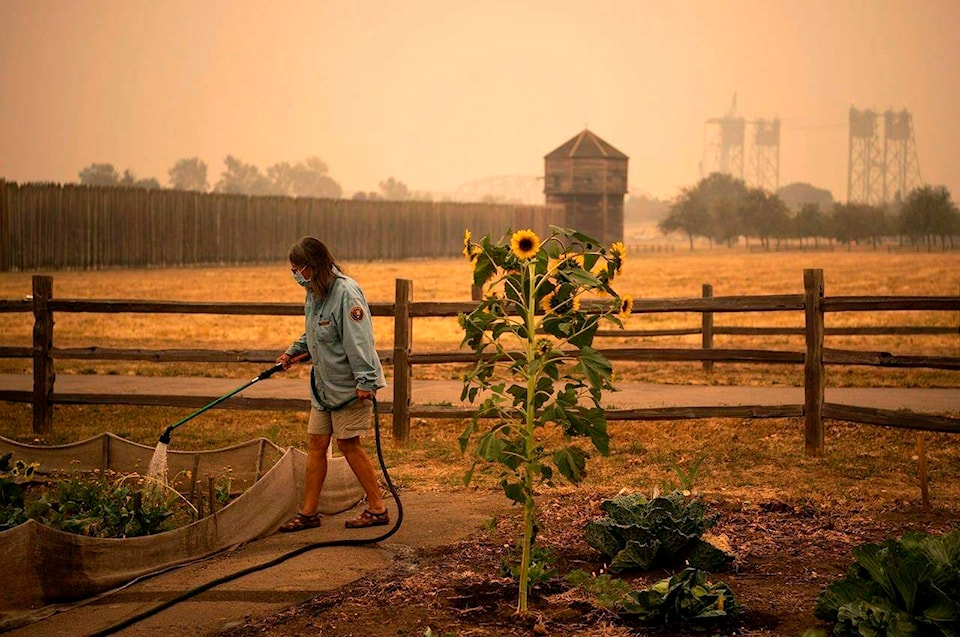Jocelyne Sewell
A Gardener’s Diary
August is gone and so is my garden.
With the heat and the smoke of the summer, I can say I had better gardens before.
I cut off all the tops of my tomato plants in the first week of August. We had a few minutes of rain on July 21 and a bit on Aug. 9 but it didn’t make any difference in the garden. Just enough to wet a few leaves.
The rain barrels didn’t overflow this summer.
Having to water everything by hand, I had to give up on a certain area of the garden.
If the smoke didn’t keep me inside most of the time, the heat did.
The peppers didn’t complain and gave me a beautiful crop.
Most of the Jalapeno peppers were purple even if I planted green ones. I read that the heat can do this so I ended up with some green, some deep purple and some ripe red ones. Makes a good colour combination.
Hoping for some rain and cooler weather, all is not lost.
I have some beds ready for a new crop. From the Farmer’s Almanac you can find some seeds that can be planted late summer.
Arugula and spinach can be planted Sept. 13, while other late dates include: beets Aug. 24, bok choy Aug. 29, carrots Aug. 19, kale Aug. 24, kohlrabi Aug. 19, lettuce Aug. 29, peas Aug. 4, radishes Sept. 3 amd turnips Aug. 29.
If the weather is still too hot, you can start your lettuce seeds in the house and transplant them when it cools down a bit which it will at some point.
For planting peas, it says Aug. 4 but you can always take a chance on a long and warm fall. When I finished harvesting my peas in July, I didn’t pull the vines but cut them off leaving some stems at the bottom. New shoots grew from there and I got some more peas. Just pulled the last ones Aug. 21. Even if you don’t get a full harvest, you might be interested in the following information.
https://wholisticmatters.com/tiny-and-mighty-the-uncommon-properties-of-the-common-pea-vine/
“Interestingly, the mix of microbes in the soil where pea vines are grown influences the nutritional value of peas and pea pods, and can even increase the antioxidants and antioxidant activity in the plant. These antioxidants scavenge reactive oxidant species (ROS). When plants have improved ROS scavenging abilities, they are better able to protect themselves from pathogens and damaging environmental factors. They also provide better nutrition to the humans that eat them,” from wholisticmatters.com.
“Every part of the Pisum sativum plant is edible, and that includes the thin pea vines and pea leaves. Since the pea plant is a climbing vine, the majority of the plant itself is comprised of its vines and leaves. The leaves contain methionine, quercetin, and anthocyanins in amounts that differ from peas and pea pods, and anthocyanins in the pea plant are found only in the leaves. Interestingly, pea leaves also contain antifungal metabolites with biological activity against fungal pathogens.
“Pea vines and pea tendrils, the new offshoots of pea vine, are edible and nutritionally dense with many of the same nutrients found in green leafy vegetables, including beta carotene, folate, and fiber. The vines are also high in manganese, potassium, calcium, and zinc, as well as vitamins C, K, and A.
“With such a wide variety of pea parts to explore, it is certainly worth taking a second look at the common pea, as well as the rest of the pea-yielding plant.”
For more information: 250-558-4556 jocelynesewell@gmail.com
READ MORE:
READ MORE:
newsroom@vernonmorningstar.com
Like us on and follow us on



